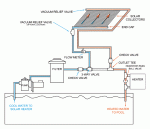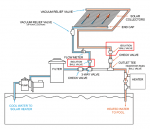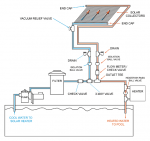I am in the SF Bay Area and have a 15k gallon in-ground pool with a 1HP pump and cartridge filter. I plan on replacing the pump and installing a solar heating system. I know that two speed pumps have a lower up-front cost, but the ability to tweak flow rates for the solar system makes a variable speed pump attractive. Would I be able to run through the solar panels on the slower speed of a two speed pump, or would I need to run at the higher speed? I am trying to determine what size pump I need and whether it makes more sense to go with a two speed pump or a variable speed pump. All of my plumbing is currently 1.5". I don't have any water features or automatic cleaners.
I have done much reading on this forum, h2otsun.com and elsewhere online and have come up with a schematic for my solar heater design. Does it matter which location I use for the vacuum relief valve? Is there any reason to put ball valves on the solar panel supply and return lines, since I can just bypass the solar system with the 3-way valve? Does it make a difference if I run 1.5" or 2" plumbing up to the roof? Am I missing anything else?
Thank you so much for the help. I knew nothing about pools when I bought this house 5 years ago and ended up with a green swamp, but thanks to this site I have a sparkling pool.
I have done much reading on this forum, h2otsun.com and elsewhere online and have come up with a schematic for my solar heater design. Does it matter which location I use for the vacuum relief valve? Is there any reason to put ball valves on the solar panel supply and return lines, since I can just bypass the solar system with the 3-way valve? Does it make a difference if I run 1.5" or 2" plumbing up to the roof? Am I missing anything else?
Thank you so much for the help. I knew nothing about pools when I bought this house 5 years ago and ended up with a green swamp, but thanks to this site I have a sparkling pool.




